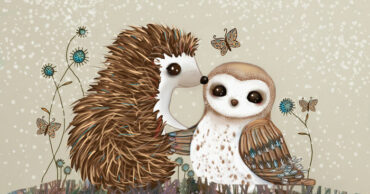I think we can all agree that birds are pretty majestic creatures. After all, they are the only ones with the ability to fly (besides the semi-flyers like those cute little squirrels and airborne fishies), causing us humans centuries of envy. But, besides the obvious, there are also plenty of other interesting things about birds, and to share them with you, we’ve created this wonderful list full of awesome bird facts. So, keep on reading!
To begin with, here’s a teensy snippet of what you might expect to read about in this list dedicated to facts about birds. Here’s one – did you know that cardinal birds cover themselves in ants? Neither did we, but to learn exactly why they do it, you’ll have to continue with this article. Also, here’s another fun fact about birds – ducks sleep with one eye open. Yeah, like from the Metallica song. Pretty hardcore, huh? However, if you weren’t expecting to read about fowl badassery and wish to share some of these cool facts with your children, you’ll definitely find some more adorable bird facts for kids. Meaning no killer ducks and no owls puking out the bones of their prey.
So, our roster of interesting bird facts is just a smidgen down below, and we think that you should definitely check them out. Be sure to rank the submissions so that the coolest animal facts will find their way to the top of this list. Also, share this article with your friends if you’d like!
#1 Chill Mode Activated
Ravens have an amazing ability to replicate human speech and sounds.
While ravens in the wild are unlikely to learn human language, they can become highly communicative when kept in captivity. Some ravens can mimic human speech as well as sounds from the human world, such as automobile engines revving or toilets flushing, better than certain parrots. In the wild, ravens sometimes imitate other animals.

#2 Shadow Play in Flight
Birds engage in interspecies play.
Crows and ravens particularly enjoy playing. To attract other birds’ attention, ravens tip their beaks at them. They remain close to their family and friends and interact with other ravens, people, and other animals while playing. They convey a range of feelings, including joy, surprise, and even rage. They live in pairs and are lifelong partners.

#3 Silent but watchful
Crows can recognize human faces.
Perhaps you shouldn’t engage in conflict with crows. The family of birds known as ravens includes crows, which are incredibly intelligent. They can even navigate in human environments and recognize human faces. Even the loss of their family members is mourned.

#4 Quack About Confidence
Some ducks sleep with one eye open.
The ducks keep watch while they slumber in groups, snoozing with one eye open. The ducks outside the circle maintain one side of their brain active when they sleep in order to prevent predators from sneaking up on them while the other ducks sleep deeper.
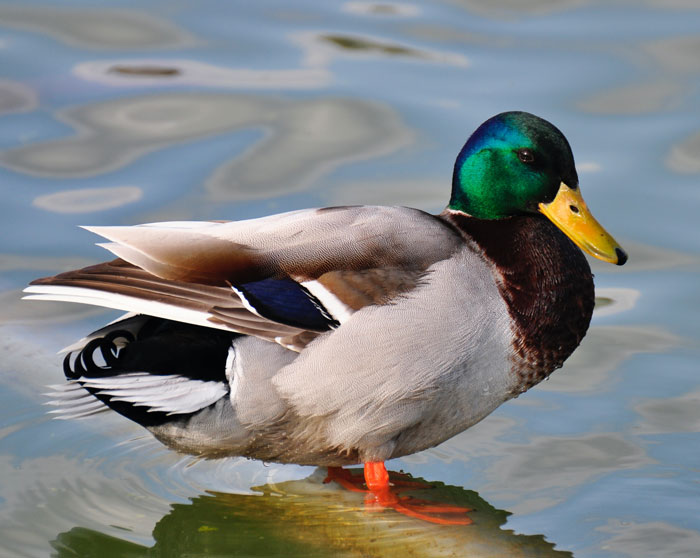
#5 Feathered Attitude Alert
The wings of newborn hoatzin chicks are covered in claws.
Young hoatzins, commonly known as “stink birds” due to their distinct odor, have two claws on each wing that they can use to clamber up tree branches or pull themselves out of the water and onto dry land, but they vanish after three months. The little hoatzins jump from their nest into the water below, swim a short distance, then use their claws to pull themselves onto land to hide from predators. They utilize their claws to scale a tree branch once the situation is safe.

#6 Wingspan Goals
Peregrine Falcon is the fastest bird on earth.
It can fly at a maximum recorded airspeed of 389 k/h while in its hunting dive (242 mph). The common swift, with a top airspeed of 169 km/h, is the quickest bird when flying level (105 mph).

#7 Flight Mode Activated
Most hummingbirds weigh less than a nickel.
Hummingbirds are very small and light. The tiniest hummingbird, the bee hummingbird, weighs less than 1.6 grams, or around the weight of a penny, while the average hummingbird weighs about 4 grams, or about one gram less than a nickel. The aptly named giant hummingbird, on the other hand, is the largest member of the hummingbird family and may grow to a maximum weight of 24 grams, which is massive for a hummingbird but only equals to a small amount of pocket coin.

#8 Loud and Clear
Unexpected Truth Teller
Serious vs. Silly
Caught Mid-Sentence
The Real Talker
Drama in the Distance
Ostriches have the largest eyes of any land animal.
Although they can’t compete with some of the enormous species that live in the ocean’s depths, ostrich eyes are the biggest of any terrestrial animal. Their eyes are really larger than their brains, about the size of a billiard ball.

#9 Feathered Firecracker
Cardinals cover themselves in ants.
Cardinals (along with several other bird species) sometimes cover themselves in crushed or living ants, rubbing them over their feathers or allowing living ants to crawl on them. While researchers are unsure of the exact function of “anting,” some think the birds use the formic acid released during their ant bath to help get rid of parasites like lice.

#10 Quietly Judging From Afar
Birds are the only animals with feathers.
Warm-blooded, egg-laying vertebrates include birds. The feathers on birds are one thing that sets them apart from other creatures. While most birds can fly, others, like penguins and ostriches, cannot. But only birds have feathers; all other animals do not. Birds use their feathers primarily for flight. To help them fly, they have muscles at the tips of each feather. Additionally, feathers aid in temperature regulation and mating attraction.

#11 Cold Crew Vibes
Gentoo Penguins are the fastest swimming birds.
Gentoo Penguins can achieve 22 mph speeds (36 kph), which is pretty fast when you’re a penguin. Emperor penguins have an 18-minute maximum submerged lifespan.

#12 Wingspan Goals
The wandering albatross can sleep flying.
With the largest wingspan of most birds in the world, albatrosses are among the largest seabirds. This bird can soar smoothly for extended periods without flapping its wings. They achieve this by using the wind energy stored beneath their wings. They can travel hundreds of miles while consuming squid and fish. It’s interesting to note that young albatrosses can live for years at sea without ever setting foot on land.

#13 Wide-Eyed Wisdom
Owls cannot turn their eyes.
Instead, they turn their heads to the side to see directly behind them. Except for Antarctica, every continent is home to them. Their wings have gentle fringes that virtually silence the flying.

#14 Feathered overachiever
Most birds do not have bladders to store urine.
The majority of birds lack bladders to hold urine, making them lighter. To eliminate waste, they create a white, pasty material rather than liquid pee. Despite not having a bladder like mammals, ostriches are unusual among birds in that their excrement and pee are completely segregated.

#15 Feathered Little Philosopher
Birds sense that winter is coming.
They can do this through hormone changes that make them gain weight. Also, the lengthening of the day and detecting minute variations in air pressure that are crucial for forecasting weather changes.

#16 Feathers and Attitude
Parrots can learn to say hundreds of words.
Some African grey parrots have been reported to memorize hundreds of words, but most parrots only learn about 50. At the Knoxville Zoo in Tennessee, Einstein, a beautiful African grey parrot, has a vocabulary of about 200 words.

#17 Quietly Observant
Bassian thrushes find food by farting.
Worm-eating Bassian thrushes have been reported to use their farts to knock their prey out of leaf heaps. The ejection of gas reportedly causes worms to move around, revealing their location.

#18 Three’s Company, One’s Quiet
Budgies catch each other’s yawns.
The only bird species that have been identified as susceptible to contagious yawning is the budgerigar, also known as a common parakeet. Budgies are the first non-mammal species to be documented engaging in the behavior, while humans, dogs, chimpanzees, lab rats, and a few other creatures have all been known to do so. According to several scientists, the automatic, instinctive reaction could be a prehistoric kind of empathetic expression or a signal of communal attention.

#19 Bold Blue Bird Energy
Birds have a unique configuration of blood vessels.
Even when standing on the ice, birds don’t lose too much heat because of a unique configuration of blood vessels that cool the blood traveling to the feet and warm the blood returning.
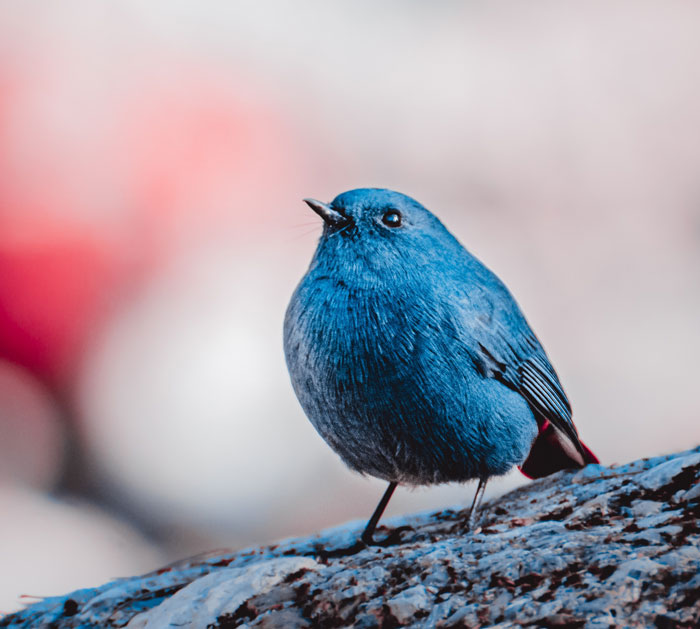
#20 Walking on thin ice
Penguins have a 9-foot vertical leap.
A penguin moves forward upright. They are proficient swimmers and spend most of their life at sea. They are also great jumpers. A penguin may leap onto the land from the water up to nine feet in the air. Penguins can occasionally jump to enter the water more quickly as they approach it.

#21 Trust Falls Only
Birds do not have teeth.
Birds do not have teeth, despite the fact that they descended from dinosaurs that did. They can better grasp their food thanks to the ridges on their beaks. Most birds don’t hunt for food; hence they don’t require teeth. Insect and small animal-eating birds utilize their beaks to snag and swallow their prey.
How do birds eat, then? They take in their entire meal at once. The gizzard, a muscular organ in the stomach, grinds the food for digestion.

#22 Almost too close for comfort
Flamingos form lifelong partnerships. Some partners stay together for 50 years or longer.
For the first time, researchers have found that friendships between birds are enduring and devoted and that physical characteristics may contribute to these ties. The durable relationships among flamingos include same-sex pals, groups of three to six close friends, and mated couples that construct nests together and nurture babies each year.

#23 Silent Night Watcher
Owls eat their prey completely.
Larger animals that owls trap, including raccoons and bunnies, are torn into smaller, easier-to-eat pieces. However, they have also been observed to swallow smaller animals whole, including mice and insects. The inedible parts of their food, such as animal bones and fur, are then regurgitated by owls in pellet form.

#24 Chasing the Sunrise
There are more than 18,000 bird species in the world.
There are many different kinds of birds around the globe. The average estimate of the number of bird species by scientists is over 10,000. New research, however, indicates that there are roughly 18,000 different bird species worldwide.

#25 Nest Goals Achieved
All female birds lay eggs.
All female birds can lay eggs, mated or not. Brown eggs, for instance, are laid by chickens with red earlobes. The color of the eggs and the red ear lobes are related genetically. Blue or green eggs are laid by the Araucana and Ameraucana chicken species. In response to environmental changes, female birds typically intensify their reproductive activity to prepare for egg-laying and caring for their young.

#26 Winging It Together
Birds congregate to defend one another.
A flock is a collection of birds. The birds that make up a flock come from the same species and move in unison. For certain species, flocking offers advantages. The majority of animals benefit from protection from predators. They may all stare in different directions when they flock, which helps them stay vigilant. When a flock spins around, a predator may feel disoriented or perplexed, making it challenging to focus on one prey.

#27 Color Clash Crew
Birds use color and sound to communicate.
You’ve probably heard birds squeaking or whistling when strolling through a park or other natural area. That sound is the exchange of messages between birds. Squeaks, singing, whistles, gurgles, warbles, trills, rattles, and many other bird sounds are communication sounds. Some birds also use nonverbal means of communication. A bird may be seen hitting the air with its wings in order to claim territory. As it dives downward, Wilson’s snipe bird spreads its distinctive tail feathers. To make a winnowing sound, it beats its wings, drawing air into its feathers. This behavior is present during courtship.
They also use visual displays to communicate. Male blackbirds stretch up their feathers and display their vibrant shoulders. Female birds choose their partner based on the male bird’s coloration or physical appeal.
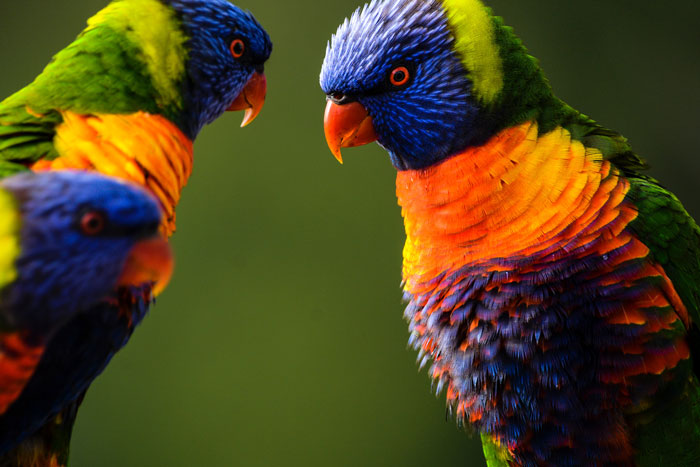
#28 Postcard From Puffin Island
Birds play a significant role in our ecosystem.
Birds pollinate by moving seeds and nutrients from one area to another while they are in the air. They are crucial to the production of agriculture. They consume unwelcome pests on livestock and crops, preventing crop depletion and pest outbreaks.

#29 Tiny Wings, Big Energy
The smallest bird is a Bee Hummingbird.
The Bee Hummingbird is the world’s tiniest bird. It has a growth range of 5–6.1 centimeters. Check your ruler to see how little that is.

#30 Pipedreams and Nesting Spots
The kiwi is the only bird with nostrils on the tip of its beak.
This positioning aids in its ability to smell food, including worms and insects on the ground. To clear its nostrils, it snorts frequently.

Image source: National Geographic
#31 Long Legs, No Mercy
Ostriches lay the largest eggs.
It weighs 3 pounds and is 7″ x 5″ in size. The kiwi, whose eggs are one-third the weight of the bird, lay the largest egg relative to the size of the mother. It is 5″ long and up to 1 lb in weight. In terms of weight, that would be the same as an ostrich laying an 88 lb. (40 kg) egg.

#32 Red Alert Mode
Perched and Poised
Striking in Silence
Nature’s Bold Accent
Monochrome with a Twist
Sharp Contrast Vibes
The rarest bird in the world is the Japanese crested ibis.
There are probably fewer than 50 crested ibises left in existence.

#33 Feathered Fashion Statement
Birds can’t fall off of a branch when they sleep.
Their toes naturally clench around the twig they are standing on, so birds don’t accidentally slip off of a branch when they are sleeping. The birds may sleep without worrying about falling since tendons, not muscles, are doing the clutching.

#34 Effortless in Motion
Many birds have lost their capacity to fly over time.
Being flightless has several benefits. For instance, a bird that cannot fly does not need to grow and maintain large flight muscles or expend the energy needed for flight. A bird without wings can also get by on less food, which enables it to endure in environments where food is in short supply.

#35 Effortless Wing Power
Pigeons delivered the Olympic game results in ancient Greece.
Pigeons, probably the earliest domesticated bird, have been used for thousands of years to convey messages, such as crucial military information and the results of ancient Olympic competitions. Pigeons were still employed to transport some letters during World War II, although non-avian mail service has grown in popularity over time.

#36 Wings of Unbothered Grace
The world’s longest bill belongs to the Australian pelican.
It measures just about 2 feet (0.5 meters). The only bird with a bill longer than its body is the sword-billed hummingbird, which has a 3.9-inch (10 cm) bill.

#37 Feathered Patient Files
American Woodcock is the slowest flying bird.
At most, it can fly at 5 mph (8 kph). Hummingbirds hover at a speed of 0 mph. Hummingbirds are the only species of bird that can fly backward while still using power, indicating a negative speed.

Image source: Wildlife Aid
#38 Strutting Into Your Day
The eyes of many ducks, including woodcocks, are situated at the sides of their heads to provide a 360-degree field of vision.

#39 Feathered Mystery Guest
Kiwis are sometimes called “honorary mammals.”
Scientists have occasionally referred to kiwis as “honorary mammals” because of their peculiar characteristics, which include feathers that feel like hair, heavy bones packed with marrow, and nostrils on the tip of their nose rather than at the base of their beak like most birds.

Image source: National Geographic
#40 Falling Without Warning
Swiftlet nests are a delicacy.
Some Swiftlets, aptly known as edible-nest Swiftlets, nearly entirely use their hardened saliva to construct their nests. The saliva nests are one of the most costly meals in the world despite having little flavor and no actual nutritional value. In some nations, they are considered a delicacy; in China, they are most usually used to make bird’s nest soup.

#41 The Bark Whisperer
Woodpeckers hoard acorns.
Woodpeckers store their nuts by boring holes in trees, fence posts, utility poles, and structures. In a single tree known as a “granary tree,” they have been found to store up to 50,000 acorns, each in its own little hole.
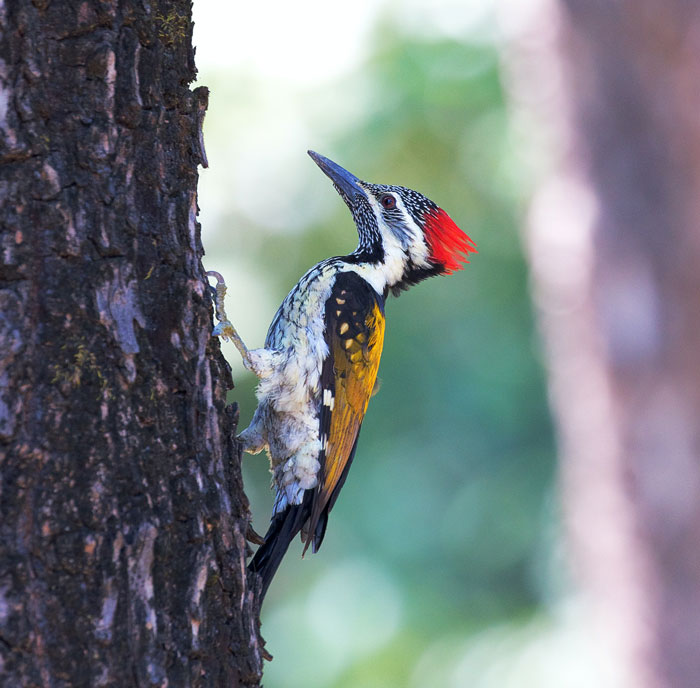
#42 Solo Chill Mode
Edge of the World
Cold and Unbothered
Just Hanging Out
Iceberg VIP Zone
Cooler Than You
Arctic Wanderer
Master of Ice
Solo on Ice
Peak Penguin Vibes
Penguins’ distinctive black and white color serves as camouflage.
While penguins may stand out on land, their all-black and all-white appearance help them blend in underwater and avoid being seen by predators and prey. They are difficult to see from above because their black backs blend in with the deeper ocean water below them as they swim. In contrast, their white chests enable them to merge with the lighter, brighter water’s surface, making them virtually invisible from below. However, in most areas, the birds confront so few predators on land that they don’t have to try to blend in. On land, their black backs may contrast dramatically with the snowy terrain.

#43 Red-Capped Contractor
A woodpecker beats its beak against a tree rather than singing as most other birds do.
Other woodpeckers can use the sound of the pounding to determine which bird it is.

#44 Winged Wisdom in Formation
Bar-headed Geese can fly across the Himalayas.
They travel approximately 5 miles (about 8,000 m) in the air, which is nearly the same as what jets do. The Griffon Vulture soars at the maximum altitude. In 1973 an accident happened when a Griffon Vulture soared more than 6.8 miles above the Ivory Coast in Africa, colliding with an aircraft.

#45 Silent Hunter Moves In
There are birds on every continent in the world.
Birds are the only animals that may be found on every continent in the world, including South America, North America, Africa, and many more. There are thousands of different species of birds. Birds may live in a variety of habitats. As the seasons change, they also move from one environment to another in search of food or shelter for their young.
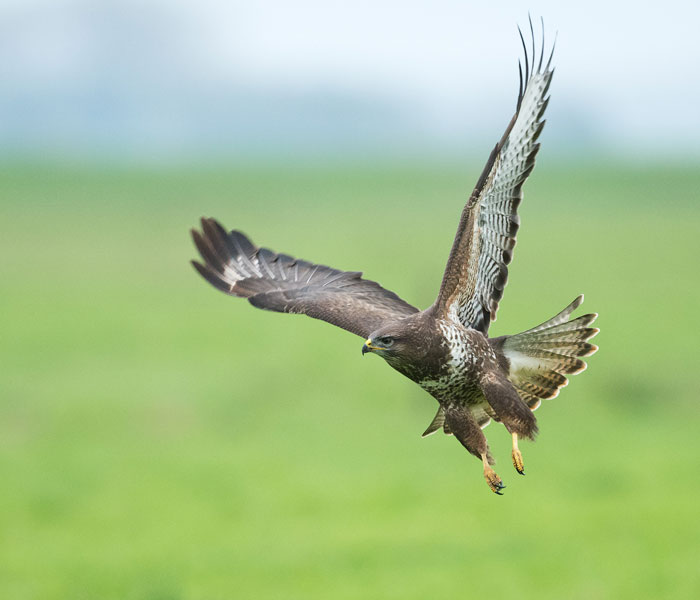
#46 Shadowed Songbird Moments
Bird feces is a crucial fertilizer.
Nutrients are largely disseminated by bird feces. Seabirds particularly play a part in this. They find land to build colonies of hundreds or even thousands of nests after months of feeding on fish and insects. When full, these birds concentrate nutrients at their breeding grounds by pooping on the shore.

#47 Wings Ready for Anything
Large portions of human history involve birds.
Humans and birds have a tight bond. A significant source of human nourishment is their eggs. Bird feathers are additionally used by people to decorate hats, caps, pencils, and other goods. People keep birds as pets rather frequently all throughout the world.
A significant component of both ancient art and outdoor entertainment involves birds. Birdwatching is a popular recreational pastime among many people.

#48 Feathered Food Fight
The number of extinct birds is rising.
Numerous studies show that bird losses are considerably more common in tropical regions due to changes in their habitat. Around 154 bird species are thought to have vanished since 1500, according to researchers. 18 species, according to researchers, are thought to have vanished in the last quarter of the 20th century.
Plant extinction, disease outbreak, and lack of pest control are just a few of the far-reaching effects that the extinction of birds could have. A lack of long-distance seed dissemination would also restrict the production of food and medication.

#49 Stealth Mode: Activated
Originally, birds were related to reptiles.
The earliest bird ever discovered, the Archaeopteryx, lived roughly 147 million years ago. This bird was very unlike those found now. It also had teeth in addition to a long bony tail.

#50 Grace in Motion
The whistling swan has the most feathers.
It has 25,000 feathers or more. On the other hand, hummingbirds are so tiny that they only have around 1,000.

#51 Rock Solid Beacon
Lighthouses are dangerous for birds.
In foggy situations, the beams draw birds, many of which are then killed by flying into the glass.

#52 Snack Time Strategist
Birds’ metabolic rates are very high.
Birds have high metabolic rates because they use large amounts of energy. However, compared to non-passerines, passerines have a higher metabolic rate. The heart rate is one sign of metabolic rates. When a hummingbird is fully in flight, its heart rate can reach 1260 beats per minute. The tiniest bird in the world, the bee hummingbird, has the highest metabolic rate.

 Follow Us
Follow Us


